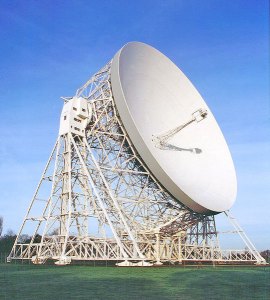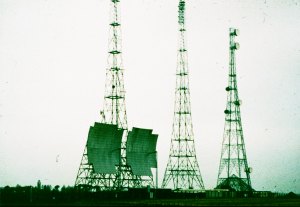After the war, the ideas and technologies developed for radar during the war were extended and applied in many other areas.
 |
|
Lovell radio telescope at Jodrell
Bank
photo courtesy: Ian Morison www.jb.man.ac.uk |
Air Traffic Control
The ‘map-like’ Plan Position Indicator became the universal form of radar display for all air and marine radars. Other radar technologies formed the basis of blind landing systems for aircraft and responder beacons used to identify aircraft.
Radio Astronomy
In 1942 radar operators observed what they thought was powerful jamming to gun laying radars. Dr J S Hey concluded that the noisy signals came from the sun. After the war, radar researchers Bernard Lovell, Martin Ryle and Robert Hanbury Brown used wartime radar technology to pioneer the new science of radio astronomy. Sir Bernard Lovell used radar to detect meteorites, and later set up the famous radio telescope at Jodrell Bank
[photo right]. Sir Martin Ryle returned to Cambridge and went on to become Astronomer Royal.
Microwave Ovens
Top Secret during the war, the cavity magnetron went on to form the source of unseen heat in microwave ovens the world over.
 |
|
Chain Home towers at Dover used to
support microwave links to mainland Europe after the
war. |
Microwave Communications
In the 1950s, beamed microwave radio communication links made use of the short wavelength radar technology. These carried telephone and television links across the country, and made nationwide television coverage possible. Satellite microwave links were behind the Eurovision television network [photo].
Semiconductors & Infra Red
During the war crystal diodes were used for radar receivers working at the higher frequencies of the cavity magnetron. After the war, WB Lewis became director of the establishment in Malvern and started the physics department for basic research into materials. This work led to the development of semiconductor infra red detectors.
In around 1950, Geoffrey Dummer, wartime inventor of the Plan Position Indicator, was the first to propose putting more than one transistor on a single semiconductor wafer - the start of the ‘micro-chip’ revolution. Later, the physics department invented Liquid Crystal Displays (LCDs) - used for displays the world over (including watches).
Other Applications - Weather radar, radar ornithology,
speed traps, medical (body) scanners. |